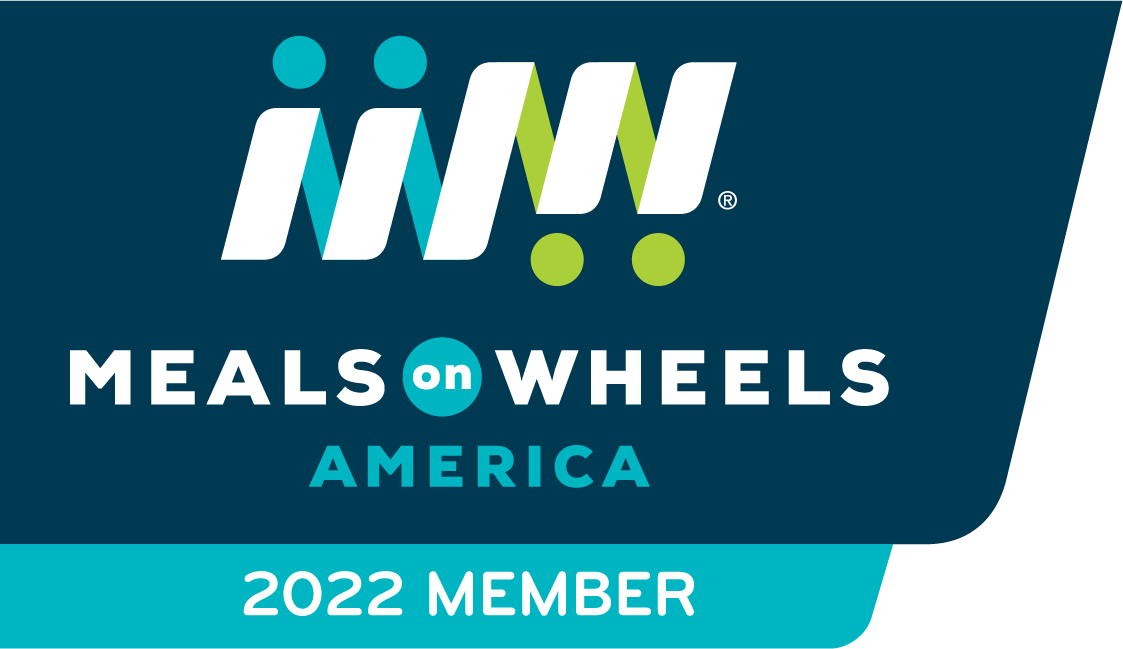The idea of “healthy aging” and “fearless aging” is not a new concept. Over the past several years, it has been growing in popularity enormously. With more baby boomers hitting retirement age every day, and average life expectancy also on the rise, our entire staff is dedicated to helping seniors achieve and maintain healthy lifestyles through education and promotion of wellness programs. Healthy Aging is a primary focus of the SeniorAge program.
We currently offer Walk with Ease classes and Living with a Better You – Managing your Chronic Disease. For information on locations, contact juli.jordan@senioragemo.org. Both are six-week workshops and offered at no cost to you.
If you would like to get connected to a variety of online activities, visit our SeniorAge area-wide wellness calendar to see what’s coming up.
Red dot events – SeniorAge hosted activities
Purple dot events – Partnership activities
Wellness Calendar
Wellness is the act of making healthy choices that lead to a fulfilling lifestyle. SeniorAge Senior Activity Centers help older adults achieve their goals through a variety of classes and programs. For example, falls prevention can be achieved through our Matter of Balance classes and pain management through CDSME and PACE arthritis exercise classes.
If you are interested in working towards a better lifestyle, or looking to maintain your daily regimen, inquire at your local Senior Activity Center about the wellness programs that might benefit you.
Here’s What Our Participants are Saying:
Francis used to sleep in her recliner chair due to painful arthritis that made it next to impossible to get in and out of bed. Since participating in Matter of Balance classes, she is now able to sleep comfortably in her own bed. ~Francis G.
Marie is just shy of 96 years old and has been active in her senior center for over 20 years. Today, she participates in a variety of wellness programs and says they help motivate her to stay active and continue exercising at home, too.” ~ Marie D.
Sylvia now has her life back thanks to her participation in wellness programs offered at her senior center. Her pedometer inspires her to do more every single day and her hopes of achieving better health, body, and mind have finally come true. “I can now sit up straight without my spine going numb; I have better endurance and a lot less stress,” she says. Sylvia is devoted to her mother who has Alzheimer’s and lives in a nursing home, but thanks to her mom’s encouragement, she now takes time for herself and feels no guilt doing it. “I’m feeling better every single day and have less pain caused from my arthritis.”
~ Sylvia H.
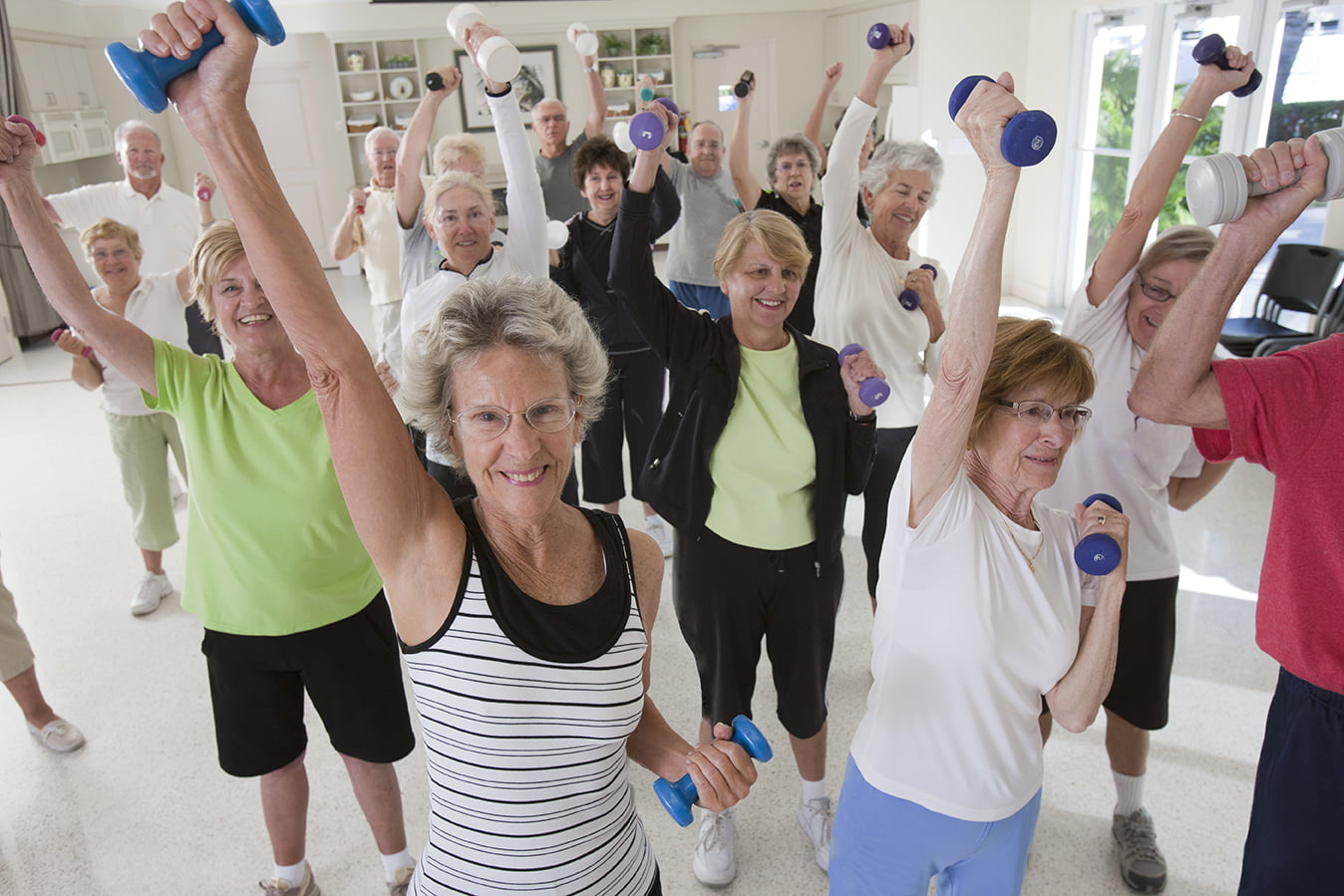
Matter of Balance
There are currently no classes being held for Matter of Balance.
Falls are the leading cause of both fatal and nonfatal injuries for those 65 years of age and older. Every 14 seconds, an older adult is seen in an emergency department for a fall-related injury. SeniorAge Senior Activity Centers are now offering Matter of Balance Classes to help individuals be more at ease on their feet. MOB classes emphasize practical coping strategies to reduce the risk of falling. Participants also find ways to change their environment to reduce fall risk factors and learn simple exercises to increase strength and balance.
A Matter of Balance is a structured group intervention that emphasizes practical strategies to reduce fear of falling and increase activity levels. Participants learn to view falls and fear of falling as controllable, set realistic goals to increase activity, change their environment to reduce fall risk factors, and exercise to increase strength and balance.
Workshops are designed for adults age 55 or older who have concerns about falling and may restrict their activities due to their fear of falling.
8 weekly sessions or twice weekly session (4 weeks). Meet 2 hours for each session.
• Emphasizes practical coping skills to reduce fear of falling and teaches fall prevention strategies.
• Structured group intervention activities include group discussion, problem solving techniques, skill building, assertiveness training, sharing practical solutions, and exercise trainings.
The Facts About Falling:
- Studies indicate that up to half of older adults experience fear of falling and that many respond to this fear by limiting physical activity.
- The majority of falls occur during routine activity.
- Falls usually are not caused by just one issue.
- A large portion of falls are preventable.
- Being inactive results in loss of muscle strength and balance. It can also compromise social interaction and increase the risk for isolation, depression, and anxiety. Fear of falling can actually contribute to falling.
- Group classes provide an opportunity for people with common problems and concerns to learn from each other and to help each other deal with the fear of falling.
After Taking A Matter of Balance Class:
- 97% of class participants are more comfortable talking about their fear of falling
- 97% feel comfortable increasing activity
- 99% plan to continue exercising
- 98% would recommend MOB to their peers.
Walk with Ease
Walk With Ease Program is a program proven to reduce the pain of arthritis and improve your overall health.
6 weeks, ongoing. Meet three times a week for 30 minutes to 1 hour each session. Participants are expected to walk on their own at least one other time each week.
• Group-based and self-directed program that combines self-paced walks with health-related discussions.
If you your group would like to schedule a Walk with Ease workshop, please call 417-868-9523.
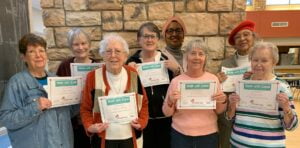
Alzheimer's Association Workshop (ALZ)
The Alzheimer’s Association is a great resource for individuals, families, and caregivers who are facing the challenges that Alzheimer’s disease presents. That’s why SeniorAge has partnered with Alzheimer’s Association to offer informational classes that can help answer questions and give you the guidance you might need.
Come learn about the signs, symptoms, causes, risk factors, diagnosis, treatment, care strategies, and resources for individuals impacted by Alzheimer’s disease or dementia. Sessions take place at the South Side Senior Center from 6:00 – 7:15 pm on the fourth Tuesday of each month. If you can’t make it in person, we also host zoom sessions from 4:30 – 5:45 pm.
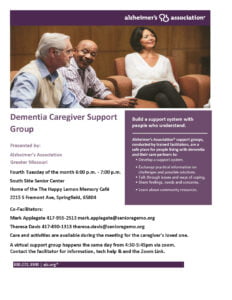
Happy Lemon Cafe’
The South Side Senior also offers the Happy Lemon Cafe’. This is a unique experience offering those affected by Alzheimer’s and dementia a place to safely participate in activities, education, and meals every Friday of each month from 11:00 am to 12:30 pm.
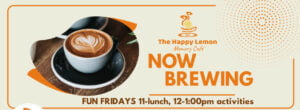
Foot Clinics
Foot problems are especially common in older people, for a variety of reasons. Feet lose cushioning as they age, and the skin and nails can grow dry and brittle. Many seniors have poor circulation, and this can slow the healing of foot sores. As we age we also become less agile, making it difficult to clip our toe nails and visually inspect the condition of our feet.
For this reason, SeniorAge Senior Activity Centers host monthly foot clinics to help seniors detect potential foot problems before the onset. Licensed specialists perform routine foot checks including foot soaks and toe nail clipping. They can alert seniors to problems before onset and guide them in seeking treatment if a condition has progressed.
Medicare will help cover the cost of foot exams and treatment if you have diabetes-related nerve damage or meet certain conditions. MO-HealthNet (formerly Medicaid) will help pay for foot care preformed by a doctor who accepts MO HealthNet.
Health Screenings
As both men and women age, health screenings become an important prevention mechanism for early detection of a potential health crisis. SeniorAge Senior Activity Centers partner with medical professionals to offer a variety of screenings at the center. Some of these services include:
- Hearing Tests
- Blood Pressure and Cholesterol
- Foot Clinics
- Flu Shots
- Bone Density
- Falls Risk Assessment
We believe it is extremely important for seniors to attend regular check-ups and take part in preventative health screenings to ensure health, happiness, and longevity. Below are some of the screenings recommended by the U.S. Preventive Services Task Force (USPSTF), created by the Centers for Disease Control:
Breast Cancer Screening
Woman over the age of 40 should receive a screening mammogram for breast cancer every 1 to 2 years. The benefits of screening to reduce breast cancer mortality are found to be strongest for women ages 50-69.
Colorectal Cancer
Both men and women should be screened for this type of cancer after the age of 50. There are a variety of screening methods and frequency recommendations, so ask your doctor what he or she recommends for your specific health situation.
High Blood Pressure Screening
Beginning at age 35 for men and age 45 for women, periodic screening for high blood pressure and high cholesterol can effectively reduce the risk of developing the serious cardiac problems associated with these conditions. In addition, adults of all ages should be screened for obesity and counseled about its related health issues.
Osteoporosis
Beginning at age 65, or age 60 if additional risk factors or present, women should have a bone density screening to assess risk for developing osteoporosis. While osteoporosis is more common among women, men should still undergo screening tests.
Visual Impairment
Though an age was not associated with this recommendation, the USPSTF recommends that all “elderly adults” should have an annual vision test. Vision problems can be the source of more serious complications and can increase a senior’s risk for falls or accidents at home. Early screening and detection can not only helps to preserve vision, but to promote independence for seniors.
Depression
Many seniors suffer from depression and/or other mental health problems, so screening for these issues is an important counterpoint to physical health screenings.
In addition to these screenings, your primary care physician may recommend other tests based on your personal health history, family history, and other risk factors. Regular visits to your doctor are critical to help prevent serious illness as you age.
Exercise and Fitness
Exercise and physical activity are good for just about everyone, including older adults. There are different types of exercises that may be better suited for your physical abilities. SeniorAge Senior Activity Centers offer a variety of fitness and exercises classes to to meet a varietey of needs.
- Endurance, or aerobic, activities increase your breathing and heart rate. Brisk walking or jogging, dancing, swimming, and biking are examples. Many of our Activity Centers have walking groups where you can enjoy a leisure stroll with friends and low-impact fitness classes like Tai-Chi and Yoga offered by partnering individuals.
- Strength exercises make your muscles stronger. Lifting weights or using a resistance band can build strength. Several of our Centers feature feature weight equipment to help in strength building.
- Balance exercises help prevent falls. When funding permits, Matter of Balance classes are offered throughout our SeniorAge service area.
- Flexibility exercises stretch your muscles and can help your body stay limber. Many of our Centers offer AFEP classes (Arthritis Foundation Exercise Program) which focus on low-impact stretching that benefit those suffering from arthritis.
Did You Know? Key Points Shared by the Surgeon General
- Older adults, both male and female, can benefit from regular physical activity.
- Physical activity need not be strenuous to achieve health benefits.
- Older adults can obtain significant health benefits with a moderate amount of physical activity, preferably daily. A moderate amount of activity can be obtained in longer sessions of moderately intense activities (such as walking) or in shorter sessions of more vigorous activities (such as fast walking or stair walking).
- Additional health benefits can be gained through greater amounts of physical activity, either by increasing the duration, intensity, or frequency. Because risk of injury increases at high levels of physical activity, care should be taken not to engage in excessive amounts of activity.
- Previously sedentary older adults who begin physical activity programs should start with short intervals of moderate physical activity (5-10 minutes) and gradually build up to the desired amount.
- Older adults should consult with a physician before beginning a new physical activity program.
- In addition to cardiorespiratory endurance (aerobic) activity, older adults can benefit from muscle-strengthening activities. Stronger muscles help reduce the risk of falling and improve the ability to perform the routine tasks of daily life.
Benefits of Physical Activity Among Older Adults
- Helps maintain the ability to live independently and reduces the risk of falling and fracturing bones.
- Reduces the risk of dying from coronary heart disease and of developing high blood pressure, colon cancer, and diabetes.
- Can help reduce blood pressure in some people with hypertension.
- Helps people with chronic, disabling conditions improve their stamina and muscle strength.
- Reduces symptoms of anxiety and depression and fosters improvements in mood and feelings of well-being.
- Helps maintain healthy bones, muscles, and joints.
- Helps control joint swelling and pain associated with arthritis.
Falls Prevention
Falls are common and falls are costly! Falls in adults age 65 and over are the leading cause of head injury and broken hips and are the leading cause of fatal and non-fatal injuries for older Americans. That’s why Area Agencies on Aging now offer proven community-based programs that help prevent falls from happening. Through practical lifestyle adjustments, evidence-based programs, community partnerships, and home safety progams, the number of falls among seniors can be reduced substantially.
Did you know?
According to the National Council on Aging:
- 1 in 4 Americans aged 65+ fall each year.
- Every 11 seconds, an older adult is treated in the emergency room for a fall
- Every 19 minutes, an older adult dies from a fall
- In 2013, the total cost of fall injuries was $34 billion (78% paid by Medicare)
- This total cost may reach $67.7 billion by 2020
- Even falls without injury can cause fear of falling leading to physical decline, depression, and social isolation.
Falls Prevention: Tips for Older Adults
Falls can result in hip fractures, broken bones and head injuries. And even falls without a major injury can cause an older adult to become fearful or depressed, making it difficult for them to stay active. If you have an aging parent, grandparent, or neighbor in your life, helping them reduce their risk of falling is a great way to help them stay healthy and independent as long as possible.
The good news about falls is that most of them can be prevented. They key is to know where to look. Here are some common factors that can lead to falls as reported by the National Council on Aging:
- Balance and gait: As we age, mosty of us lose some coordination, flexibility, and balance— primarily through inactivity, making it easier to fall.
- Vision: In the aging eye, less light reaches the retina—making contrasting edges, tripping hazards, and obstacles harder to see.
- Medications: Some prescriptions and over-the-counter medications can cause dizziness, dehydration or interactions with each other that can lead to a fall.
- Environment: Most seniors have lived in their homes for a long time and have never thought about simple modifications that might keep it safer as they age.
- Chronic conditions: More than 90% of older adults have at least one chronic condition like diabetes, stroke, or arthritis. Often, these increase the risk of falling because they result in lost function, inactivity, depression, pain, or multiple medications.
There are many simple and inexpensive ways to make a home safer:
- Lighting: Increase lighting throughout the house, especially at the top and bottom of stairs. Ensure that lighting is readily available when getting up in the middle of the night.
- Stairs: Make sure there are two secure rails on all stairs.
- Bathrooms: Install grab bars in the tub/shower and near the toilet. Make sure they’re installed where your older loved one would actually use them. For even greater safety, consider using a shower chair and hand-held shower.
CPR
Each year, more than 350,000 out-of-hospital cardiac arrests occur in the United States. When a person has a cardiac arrest, survival depends on immediately getting CPR from someone nearby. Almost 90 percent of people who suffer out-of-hospital cardiac arrests die. CPR, especially if performed in the first few minutes of cardiac arrest, can double or triple a person’s chance of survival.
If you are called on to give CPR in an emergency, you will most likely be trying to save the life of someone you love: a child, a spouse, a parent or a friend. 70 percent of out-of-hospital cardiac arrests happen in homes. Unfortunately, only about 46% of people who experience an out-of-hospital cardiac arrest get the immediate help that they need before professional help arrives. That’s why SeniorAge is taking a proactive move towards training our Senior Center Staff in CPR procedures.
As of 2016, all of the SeniorAge Activity Centers are equipped with automated external defibrillator (AED) machines, a portable electronic device that automatically diagnoses life-threatening cardiac arrhythmias and walks the user through the life-saving procedures when immediate medical assistance is not available.
Want to become CPR Certified?
SeniorAge offers classes to our communities on how to properly perform CPR to both adults and adolescents. Trained instructors demonstrate and teach practices based on the American Heart Institute guidelines and procedures. Participants are then graded by test and demonstration of skills in order to pass the class and receive certification. For more information and upcoming class schedules, contact Sheila Smith at sheila.smith@senioragemo.org.
Living with a Better You
Diabetes, arthritis, hypertension, lung disease. Chronic diseases like these can force seniors to give up their independence too soon. About 80% of older adults have at least one chronic disease, and 68% have at least two. SeniorAge hosts proven programs that can empower you to manage your own care and improve your quality of life.
Chronic Disease Self Management Education (CDSME) programs are growing by the day! Since 2006, more than 300,000 people have participated in a CDSME program. More than 24,500 workshops were hosted throughout the country with an average of 12 participants in each class.
SeniorAge is proud to offer CDSMP, Living With a Better You, which focuses on ways to make the best of who you are. Whether you live with chronic pain, have anxiety, or just want to live your best life, our interactive class will offer a little something for everyone.
Don’t worry, there is no charge for the class. Give us a call at 417-868-9523 or email juli.jordan@senioragemo.org for more information, to register, or to schedule a free workshop with your group. We also offer Chronic Disease in the Workplace, a very similar workshop that can take place via Zoom sessions.
